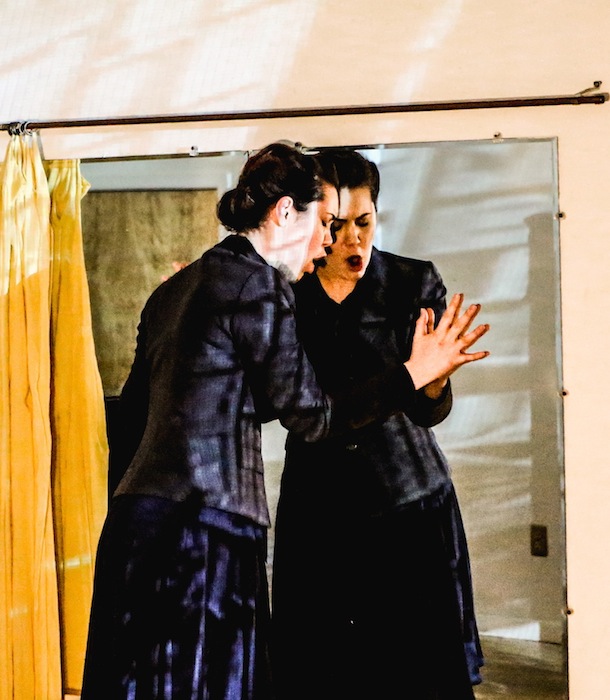Boston Opera Collaborative’s staged song cycles examines women’s contrasted lives

Boston Opera Collaborative presented “Mirror,” a performance of staged song cycles by Schumann and Argento Friday night. Photo: Dan Busler
Some composers have dealt with the lives of women. Yet their portrayals differ widely.
The most famous example is Schumann’s Frauenliebe und –leben, a song cycle that tells of a woman’s journey into courtship, marriage, motherhood, and widowhood. A century later, Dominick Argento penned From the Diary of Virginia Woolf. Here the woman is solitary, a figure drawn increasingly inwards with results that lead to depression and madness.
Members of the Boston Opera Collaborative performed both works as part of a mesmerizing and interactive concert experience Friday night at Longy Conservatory.
Billed as “Mirror,” the production invited a small band of listeners to follow the characters from room to room in Longy’s historic Zabriskie House. Each of the eight scenes offered a song from one of the cycles, drawing the listeners into the inner world of the characters.
Schumann’s woman was portrayed by Julia Cavallaro, who sang with a round, chocolaty tone. Listeners witnessed her transformation from girlfriend to elated bride in a world where a woman was defined primarily by her relationship to her husband.
Yet Cavallaro found an interpretation of enveloping warmth that still managed to speak to modern listeners. In the opening “Seit Ich ihn gesehen,” we see a woman looking gleefully into a hand mirror. Through music of quiet reverence, the woman dreams of a future with her beloved. The accompaniment conveys the sense of anticipation through gentle dissonances.
Argento’s woman, performed by Krista Marie Laskowski, lives in a world of inner turmoil. She grows coldly distant with the materials in her life. The opening song, “The Diary,” reflects the worthlessness of everyday objects, yet those pieces become meaningful with the passage of time. Later, the woman is drawn into an elated sense of nostalgia for days that can never live again. Argento’s music, with its mix of speech-like melody and bristly dissonance, makes these feelings palpable. Laskowski conveyed the role with singing of bright elegance that delivered a keen sense of humanity in a character drawn into desolation.
Argento’s cycle was inspired by Schumann’s, and one gathered a similar sense of story arc as the two works were performed side by side. Some scenes in this production offered stark contrasts. Schumann’s “Süßer Freund, du blickest mich verwundert an” showed the woman trembling with anticipation over the wedding night union with her husband. In the song, she gestures to the edge of her bed, where a cradle is placed; the relationship will bring new life. Argento’s woman, on the other hand, reflected on the coming of World War II. With bare, bristly statements from the piano as accompaniment, the woman sang that she might not live to see her next birthday.
But life endures. Scene seven is set in a nursery. Schumann’s woman cradles her newborn baby as she sings “An meinem Herzen, an meiner Brust,” which tells of the ultimate happiness that motherhood brings. Argento’s woman, sitting in chair, muses over family photographs. Her happiness is in the past. The bare, angular music from “War” returns and the woman is transfixed, caught up in her present grief.
In the final scene, a funeral parlor, the order is reversed. In “Last Entry,” Laskowski’s singing captured a belated strength, a last gasp of sanity as her character descends into the gloom. Cavallaro, meanwhile, sits in front of a coffin. Her husband has died, and as she sings “Nun hast du mir den ersten Schermz getan” she feels the ultimate pain of marriage. Death, in this moment, seems to speak for both women.
At the piano, Jean Anderson Collier sensitively conjured the contrasted sound worlds for both women. Her tempos were nimble, her phrasing supple.
Sets were minimal but effective. The Zabriskie House’s old-style furniture transformed each space into parlors, dressing rooms, and funeral chapel that let listeners’ imaginations fill in the rest. Schumann and Argento’s stories, in the end, remain a theatre of the mind.
The program runs through Sunday at Longy Conservatory. bostonoperacollaborative.org
Posted in Performances



